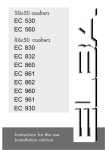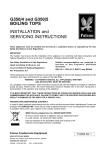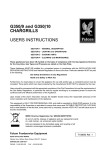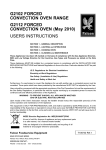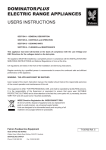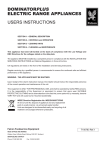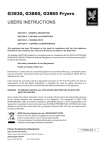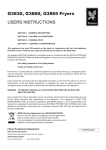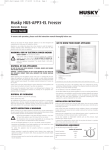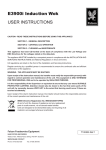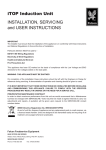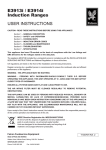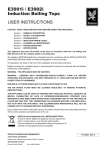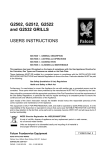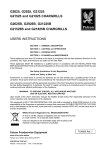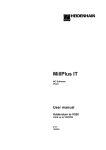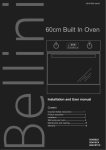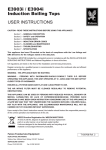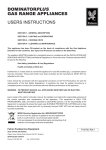Download Falcon 350 Gas Open Top Range User Manual for G350/1 model
Transcript
G350/1 OPEN TOP RANGE G350/2 SOLID TOP RANGE USERS INSTRUCTIONS SECTION 1 - GENERAL DESCRIPTION SECTION 2 - LIGHTING and OPERATIONS SECTION 3 - COOKING HINTS SECTION 4 - CLEANING and MAINTENANCE These Appliances have been CE-marked on the basis of compliance with the Gas Appliance Directive for the Countries, Gas Types and Pressures as stated on the Data Plate. These Appliances MUST BE installed by a competent person in compliance with the INSTALLATION AND SERVICING INSTRUCTIONS and National Regulations in force at the time. Particular attention MUST be paid to the following: Gas Safety ( Installation & Use) Regulations Health and Safety at Work Act Furthermore, if a need arises to convert the Appliance for use with another gas, a competent person must be consulted. Those parts which have been protected by the manufacturer MUST NOT be adjusted by the User. Users should be conversant with the appropriate provisions of the Fire Precautions Act and the requirements of the Gas Safety Regulations. in particular the need for regular servicing by a competent person to ensure the continued safe and efficient performance of the Appliance. Upon receipt of the User's Instruction manual, the installer should instruct the responsible person(s) of the correct operation and maintenance of the Appliance. This equipment is ONLY FOR PROFESSIONAL USE, and shall be operated by QUALIFIED persons. It is the responsibility of the Supervisor or equivalent to ensure that users wear SUITABLE PROTECTIVE CLOTHING and to draw attention to the fact that, some parts will, by necessity, become VERY HOT and will cause burns if touched accidentally. WEEE Directive Registration No. WEE/DC0059TT/PRO At end of unit life, dispose of appliance and any replacement parts in a safe manner, via a licenced waste handler. Units are designed to be dismantled easily and recycling of all material is encouraged whenever practicable. Falcon Foodservice Equipment HEAD OFFICE AND WORKS Wallace View, Hillfoots Road, Stirling. FK9 5PY. Scotland. SERVICELINE CONTACT PHONE - 01438 363 000 FAX - 01438 369 900 T100555 Ref.1 SECTION 1 - GENERAL DESCRIPTION The 350/1 open-top range and G350/2 solid-top range are two floor standing ranges in the Falcon 350 series. All individual units comprising the Series are of modular dimensions, enabling suites of appliances to be installed in a matching line. Some units are for "counter" mounting, meaning that they can be installed either on a table or similar, or alternatively on purpose-made stands, supplied by Falcon, which ensure perfect matching of hob- height when installed with floor-standing appliances such as the ranges. The G350/1 is a range with 4 open-top burners each 4.3kW(14,700 Btu/hr) heat rating, controlled by safety taps. The oven, fitted two doors, is heated by a thermostatically controlled burner of 4.75kW (16,200 Btu/hr), protected by a flame failure device and equipped with push-button ignition. The oven has a nominal volume of approximately 0.09m3 (3.26ft3) and is supplied with two wire grid shelves. Five shelf positions are provided. The G350/2 solid top range has an oven identical to the G350/1 , but has a heavy-duty solid-top. The solid top consists of the traditional centre ring and side fillings and is heated by a single burner of 7.7kW (26,800 Btu/hr) capacity. It is controlled by a combined on/off tap and flame-failure device, ignition of the burner being by a manually-lit pilot. The tap has indented positions for full flame and "simmer". Open Top Taps SECTION 2 - LIGHTING and OPERATIONS 2.1 Open Top All four burners are equally rated and may be used for fast boiling or simmering. The pan supports, which are interchangeable, will safely accommodate pans from 125mm diameter upwards. The gas taps are of the safety type and include a flame failure device. To Light The Burner Identify appropriate tap by observing the facia panel marker . Push the tap knobs inwards then turn fully anti-clockwise to the FULL FLAME setting and hold the control knob in for approximately 20 seconds whilst applying a lit match or taper to burner head rim. The knob can then be turned anti-clockwise to reduce flame, if desired. To Turn The Burner OFF Simply turn knob clockwise as far as it will go (see Figure 3). OFF 2.2 Solid Top Warning FULL ON (turn anti-clockwise) Figure 3 SIMMER (turn further anti-clockwise) If pilot is extinguished intentionally or unintentionally, no attempt to re-light the gas should be made until at least 3 minutes have elapsed. The procedures are as follows - Oven Control (Thermostat) Lighting The Burner (Refer to Figure 4) Spark Igniter Button (in Front Frame behind LH Door) Flame Failure Button (in Front Frame behind RH Door) Figure 1 - Open Top Range Solid Top Control (Thermostat) Oven Control (Thermostat) Spark Igniter Button (in Front Frame behind LH Door) Flame Failure Button (in Front Frame behind RH Door) Figure 2 - Solid Top Range 1. Remove solid-top centre ring using special tool provided. 2. Have a lit taper or match ready in one hand. 3. With other hand, push in control knob and turn it anti-clockwise until mark on knob is opposite ignition symbol. 4. Apply light to pilot, still keeping knob pushed in. 5. After about 20 seconds, release knob, pilot should remain alight. If not, push in control knob and turn clockwise to OFF position. Wait 3 minutes, then repeat from step 2. 6. With pilot flame established, replace solid top centre ring. 7. Push knob in again and turn it anti-clockwise to FULL FLAME symbol thus lighting burner. 8. If desired, burner can be turned down to LOW or SIMMER setting by further depression of knob and turning it fully anti-clockwise to small flame symbol. To Turn The Burner OFF 9. To turn off main burner but leaving pilot lit, push in knob and turn to ignition symbol. 10. To turn off main burner and pilot, push in knob and turn to OFF position. Note It will be seen from the above detailed instructions that every turning movement of the knob has to be preceded by pushing it in. Ignition Full Flame Low Flame Getting the best out of this type of heat source is obviously largely a matter of experience, coupled with the needs of the particular task in hand. For certain applications, such as heating a pot quickly, it will be found expedient to remove the centre ring and place the pot directly over the burner. If on the other hand, it is necessary to heat the entire surface, the ring must be in place. In the interests of economy it is recommended that the solid-top should not be left unattended with the gas on FULL setting. If it is necessary to keep the top hot for any length of time, control should be turned down to LOW setting. Do not at any time leave the gas on whilst centre ring is removed - such practice simply wastes gas. The hottest area of the plate is in the centre and toward the rear, the front and side are cooler. 3.2 Using The Oven Figure 4 2.3 OVEN To Light The Oven Burner Proceed as follows 1. Open oven doors to gain access to the flamefailure and igniter buttons (see Figures 1 & 2). 2. Push in and turn thermostat knob anti-clockwise to maximum setting. 3. Push in flame-failure button and keep pressed in. 4. Push igniter button and burner should light. If it does not light immediately, repeatedly press and release igniter button until it does. 5. Keep flame-failure button pressed in for approximately 15 seconds, then release it. Burner flame will now increase to maximum and oven doors can be closed. The thermostat knob can be turned to desired setting. To Turn The Oven OFF SECTION 3 - COOKING HINTS 3.1 Solid Top Push in and turn thermostat knob fully clockwise to OFF position. The cooking chart provides a selection of conditions for cooling selected types of food, and to ensure satisfactory performance the following instructions should be observed. Grid Shelves Space these at least two runners apart. In the cooking chart, the runners are numbered downwards. i.e. No. 1 is at the top. Tray Size A cake tray up to 400mm x 490mm (153/4" x 191/4") can be used on each shelf. Alternatively, gastronorm 1/1 trays can be used. A single baking tin (e.g. School meals type) 405mm x 265mm (16" x 101/2") can be accommodated on each shelf. Pre-Heat Time Allow at least 40 minutes from lighting a cold oven before loading the oven. Put the food in quickly and close the doors without delay. Thermostat The desired oven temperature will be maintained automatically at the temperature (o C) selected. These are approximate centre oven temperatures and cooking conditions for each position. Condition Min. Heat Moderate Fairly Hot Temp oC 120 150 180 Condition Hot Very Hot Max. Heat Temp oC 210 240 270 SUGGESTIONS FOR ROASTING MEAT 1. High Temperature Method (FAST) Times are for average requirements. The quality and shape of meat will affect the time required. 2. Low Temperature Method (SLOW) This requires a longer cooking time but reduces loss in weight and allows more even cooking. This method is preferable for less tender joints. Meat/Poultry QUICK ROASTING SLOW ROASTING Beef (on the bone) Beef (no bones) allow 15 mins per allow 20 mins per 0.5kg (1 lb) 0.5kg (1 lb) allow 20 mins per allow 30 mins per 0.5kg (1 lb) 0.5kg (1 lb) allow 20 mins per allow 30 mins per 0.5kg (1 lb) 0.5kg (1 lb) allow 25 mins per allow 35 mins per 0.5kg (1 lb) 0.5kg (1 lb) 45 - 90 mins acc. to 60 to 120 mins acc. size and age to size and age 15 mins per 0.5kg 20 mins per 0.5kg (1 lb) plus 15 mins (1 lb) plus 15 mins Mutton, Lamb Veal, Pork Chicken Goose, Duck, Turkey 3. Baking on ONE Shelf When cooking small cakes, scones, etc, in small quantities, position the grid shelf on runner 2 or 3. 4. Baking onTWO Shelves (Small cakes etc) For larger quantities of cakes, scones etc, which necessitates two shelf cooking. use runners 2 and 4. Normally the top tray will have to be removed from the oven first, the lower tray being moved up to the vacated position. 5. Milk Puddings, etc. Milk puddings, including Yorkshire can also be cooked on two shelves. Both can normally be taken out of the oven at the same time if interchanged half way through. 6. Baking Large Cakes - Fruit Cakes in Large Tins These can be cooked on two shelves. It is advisable to interchange the upper and lower tins halfway through the estimated cooking times, thus enabling both to be cooked in about the same time, and lessening the chances of over or undercooking. Average Cooking Times and Settings The oven should be pre-heated for 40 minutes at the appropriate gas mark setting before food is inserted. These values are approximate and will generally be found to be satisfactory in normal conditions. MEAT Meat Roast (Fast) Meat Roast (Slow) Poultry (Slow) Thermostat Runner Setting oC Position 210 160 160 Braising 145 Casseroles 120 PUDDINGS Custard Milk Yorkshire Pudding PASTRY Thermostat Runner Setting Position 210 Plate Pies 210 Scones CAKES Slab Cake (Rich) Slab Cake (Plain) Queen Cakes Sponge Sandwich Very Rich Cakes(Xmas) Bread Rolls 225 - 250 225 - 250 250 Note according to weight 1 & 2 according to weight 1 & 2 3 according to weight 1 & 2 or 5 30 mins per 0.5kg for (1lb) + 30 mins. two shelves 11/2 to 3 hours Thermostat Runner Setting oC Position 2 for 145 single tray, 120 2 and 4 for two trays 225 Fruit Pies Puff and Rough Puff Sausage Rolls 3 for single shelf, Time 2 for single tray, 2 and 4 for two trays Thermostat Runner Setting Position Time Note 40 to 60 minutes 3&4 45 to 90 minutes 3&4 40 to 50 minutes 3&4 Time Note 30 to 40 minutes 3&4 40 to 50 minutes 3&4 10 to 15 minutes 3&4 20 to 25 minutes 3&4 10 to 15 minutes 3&4 Time Note 120 5 5 145 5 5 200 as for pastry 15 to 20 minutes 3&4 20 to 25 minutes 3&4 145 3 2 to 3 hours 5 225 - 250 5 15 to 25 minutes 5 200 SECTION 4 - CLEANING and MAINTENANCE Before cleaning, allow unit to cool sufficiently. Clean with warm soapy water at the finish of each working day, using nylon pads for stubborn deposits. After cleaning, rinse with clean water and dry. DO NOT use proprietary cleaners, especially those which may have a high caustic content, on the vitreous enamelled surfaces of this unit. Before removing any parts for cleaning, take note how they are located to assist in fitting them in later. Solid Top It is recommended that after cleaning solid top, the castings should be lightly smeared with cooking oil. Oven Clean whilst oven is warm (not hot). The enamelled base plate lifts out and the grid shelves and side shelf-runners can be removed. The grid shelves are removed by tilting them upward until the shelf tops are passed, then pulled forward until the second shelf stop is reached. Tilt shelf upward over stop and pull it clear of oven. The wire shelf runners can be removed by lifting upwards until the lower ends are clear, then downwards. Pan Supports Clean with warm soapy water. Abrasives such as fine steel wool, proprietary cleaning pads or nylon pan scrubbers, should be used with care and only in cases of extreme overspill. Dry off the pan supports by hand. NEVER LEAVE TO DRY NATURALLY. After drying, apply a light film of vegetable oil. This will prevent oxidisation. Door Catch 1. Occasional lubrication will extend catch working life. To do this, press roller and pass high melting point lubrication behind roller. 2. Adjustment to ensure positive door closure can be provided by pressing and turning roller left to slacken or right to tighten.





